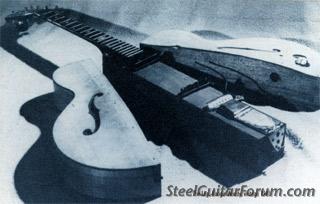


Paul's innovative guitar, "The Log", built after-hours in the [ame="http://en.wikipedia.org/wiki/Epiphone"]Epiphone[/ame] guitar factory in 1940, was one of the first solid-body [ame="http://en.wikipedia.org/wiki/Electric_guitar"]electric guitars[/ame].[25] [ame="http://en.wikipedia.org/wiki/Adolph_Rickenbacker"]Adolph Rickenbacker[/ame] had marketed a solid-body guitar in the 1930s and [ame="http://en.wikipedia.org/wiki/Leo_Fender"]Leo Fender[/ame] also independently created his own in 1946. Although Paul approached the [ame="http://en.wikipedia.org/wiki/Gibson_Guitar_Corporation"]Gibson Guitar Corporation[/ame] with his idea of a solid body electric guitar, they showed no interest until Fender began marketing its [ame="http://en.wikipedia.org/wiki/Fender_Esquire"]Esquire[/ame] and [ame="http://en.wikipedia.org/wiki/Telecaster"]Telecaster[/ame] models. Gibson designed a guitar incorporating Paul's suggestions in the early 1950s and presented it to him to try. He was impressed enough to sign a [ame="http://en.wikipedia.org/wiki/Testimonial"]endorsement contract[/ame] for what became the [ame="http://en.wikipedia.org/wiki/Gibson_Les_Paul"]Gibson "Les Paul"[/ame] model, originally only in a "gold-top" version (official name: "Les Paul Standard"), and agreed never to be seen playing in public, or be photographed, with anything other than a Gibson guitar.[[ame="http://en.wikipedia.org/wiki/Wikipedia:Citation_needed"]citation needed[/ame]]
